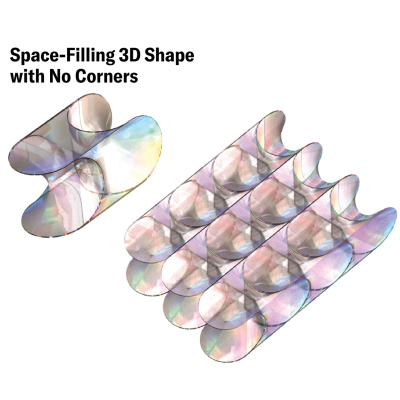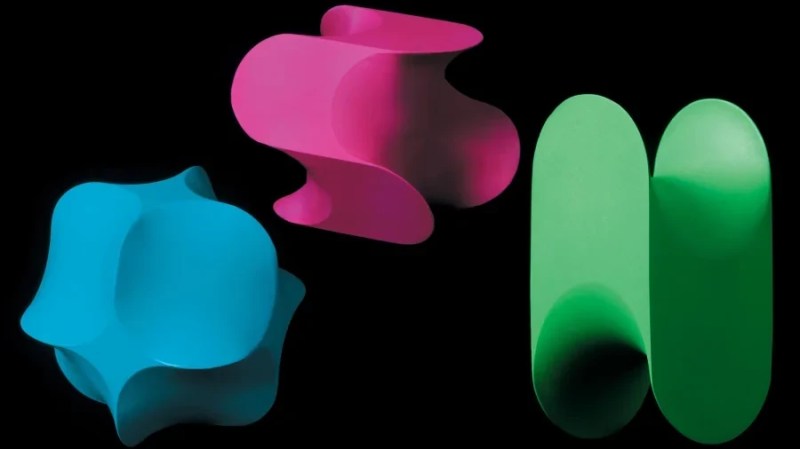Tiling a space with a repeated pattern that has no gaps or overlaps (a structure known as a tessellation) is what led mathematician [Gábor Domokos] to ponder a question: how few corners can a shape have and still fully tile a space? In a 2D the answer is two, and a 3D space can be tiled in shapes that have no corners at all, called soft cells.
 These shapes can be made in a few different ways, and some are shown here. While they may have sharp edges there are no corners, or points where two or more line segments meet. Shapes capable of tiling a 2D space need a minimum of two corners, but in 3D the rules are different.
These shapes can be made in a few different ways, and some are shown here. While they may have sharp edges there are no corners, or points where two or more line segments meet. Shapes capable of tiling a 2D space need a minimum of two corners, but in 3D the rules are different.
A great example of a natural soft cell is found in the chambers of a nautilus shell, but this turned out to be far from obvious. A cross-section of a nautilus shell shows a cell structure with obvious corners, but it turns out that’s just an artifact of looking at a 2D slice. When viewed in full 3D — which the team could do thanks to a micro CT scan available online — there are no visible corners in the structure. Once they knew what to look for, it was clear that soft cells are present in a variety of natural forms in our world.
[Domokos] not only seeks a better mathematical understanding of these shapes that seem common in our natural world but also wonders how they might relate to aperiodicity, or the ability of a shape to tile a space without making a repeating pattern. Penrose Tiles are probably the most common example.
















Nautiluses don’t know how to make corners.
Tainted Math!
Sometimes I feel I want to, bum bum,Tessellate…
Wordplay. Maybe not “corners”, but edges, and the edges are continuous deformations of what were once corners.
It’s not wordplay, it’s math. Sharp corners have different derivatives in all dimensions compared to edges: with an edge, there’s a path you can take that has a smooth derivative, with a corner, there is none.
I haven’t seen “corners” mentioned in 3D math, it is always about vertices and edges. And space filling tiling shapes without vertices are pretty nifty. And removes the ambugitidy of “corners”
If you look at the article, it’s not just vertices, it also includes cases where you form a cusp in 2D. I can’t think offhand how you’d define it (and can’t read the paper at the moment), but it’s going to be similar to a smooth derivative.
Jeez, found it 2 seconds later. It’s s corner if no smooth curve on the boundary contains that point. So 2 faces bent into a cusp are a corner because there’s no curve including those points (only a line).
It might also have physical implications, e.g. in terms of whether these shapes will pack themselves optimally under compression. If there is a differentiable curve through every point on the boundary, then there’s no way for any number of shapes to touch where they can’t slide against each other. Though I’m sure there’s more to it than that.
Corners are infamous weak points in many situations… so are edges but perhaps not as much. Sometimes in mathematics the theory comes a long time before you figure out the application, which is part of the fun :)
Fermat’s little theorem went somewhere around 337 years before it found practical use in RSA encryption. That’s the one downside of pure mathematics.
Maybe would have been more descriptive to use “vertices,” spots where several edges meet
Whoops didn’t read the thread award, my bad
Pringles solved this long ago
The cross section of a stack of Pringles is a circle so it wouldn’t work. If you put two stacks of Pringles next to each other there wouldn’t be a way to fill the gap between them fully with Pringles.
IDK, been printing gyroid infill for a while, not a lot of corners there….
gyroid definitely fills space ;-)
If you define a finite, three-dimensional unit cell that can be assembled into gyroid infill, the shape within that cell may have corners (where you cut through the infill pattern).
But more to the point, it doesn’t fill space (the point of infill being to fill as little space / use as little material as possible)…
What would the unit cell of a gyroid look like?
It would just look like you cut out a cubic piece of infill, suitably sized and oriented so that the edges match up when you repeat it.
The repetition doesn’t necessarily have to be like stacking sugar cubes in a box. You can use any combination of translations, rotations and reflections of the unit cell to tesselate space, as long as the set of transformations you use form a [space group].
It’s like how you can have wallpaper with flowers all over it, and even though the flowers are all entwined, if you cut out a rectangle of the right size, you can generate the whole pattern by repeating that rectangle. Actually, the 2D equivalent of space groups are called “wallpaper groups”, and are a pleasing subject.
One of my students has a Scientific American subscription and brought this article to class this week. It’s so amazing to see just how engrossing topology is for many students that would otherwise not engage with other mathematics. A vigorous and cheerful discussion regarding the nature of an edge and how to best color these shapes is still ongoing with every single student throwing in at least a few ideas.
I am convinced that nearly all enthusiasm and talent for math comes from the ability to think about concepts visually. Some forms of math are easier to visualize than others
Edges are pretty much the 3D equivalent of 2D corners, though.
Do they define a corner as 3 flat planes coming together? The shape with the saddles- if you cut it in half horizontally it’s a square don’t seems to basically be a cube with saddles on top and bottom. It definitely has edges… to me. Like mentioned above but not expanded on its a Pringle chip thickened vertically with squared off (edges?) to make it stackable to fill entire space.
.
Seems to my ignorant self a classic difference between lay definition used by everyone of an edge and specific sciencey definition.
Sorry to self reply.
But if I put someone inside that shape with the saddles and told them to stand in the corner it would be obvious how to do it.
This is unnecessary twisting of words.
There is no such thing as a “corner” in 3d space anyway, and those “edges” are just as much of a problem as 2 flat planes meeting anyway.
So…cool?
Here are some space filling 3d shapes that have non-flat sides.
Isn’t it this tiling which is misleading ?
In my perspective, tiling in 2D is filling the entire form. But the tiling done here, in the 3d shape, is just a 2d tiling.
No, the 3d shapes fit together in a way that leaves no internal voids.
There are other problems with the description, like the arbitrary choice to do it without “corners”, which is a feature that doesn’t exist in 3d space anyway, but the use of “tile” is far less troublesome.
The overall term tesselation is used for space filling in any dimensions.
Tiling is (strangely) used for 2d and 4d+.
3d tessellation has it’s own special name, Honeycomb, even when the shapes aren’t hexagonal.
Packing is a similar term, but also includes arrangements with voids, which tesselation does not.